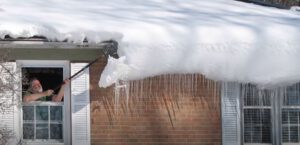 Ice dams are a common problem for homeowners in colder climates during winter. They form when snow accumulates on the roof, melts, and then refreezes at the edge of the roof, creating a barrier that prevents proper drainage. This can lead to water damage inside your home and even cause structural damage to your roof.
Ice dams are a common problem for homeowners in colder climates during winter. They form when snow accumulates on the roof, melts, and then refreezes at the edge of the roof, creating a barrier that prevents proper drainage. This can lead to water damage inside your home and even cause structural damage to your roof.
While Australians may not experience the same extreme winter conditions as those in the northern hemisphere, it’s still important to know how to prevent ice dams from forming on your roof. In this article, we’ll go over some tips on how to prevent ice dams on your Australian roof during winter.
What Are Ice Dams?
Ice dams are a common winter problem for homeowners in colder climates. They form when snow accumulates on the roof, melts, and then refreezes at the edge of the roof, creating a barrier that prevents proper drainage. This can lead to water damage inside your home and even cause structural damage to your roof.
What Causes Ice Dams?
Before we go over how to prevent ice dams, let’s take a look at what causes them. Ice dams form when heat from inside your home escapes into your attic and warms up the roof. This causes snow on the roof to melt, but the melted snow then refreezes when it reaches the cold eaves or gutters. Over time, this creates a buildup of ice at the edge of the roof, which can trap more snow and cause water to seep into your home.
What Are The Dangers of Ice Dams?
Ice dams can cause a number of issues. The most common issue is water damage inside your home. As the ice dam blocks proper drainage, water will start to back up and eventually find its way into your walls, ceilings, and insulation. This can lead to mold growth and structural damage as well as decreased energy efficiency.
 Another issue caused by ice dams is gutters that are pulled away from the roof due to the weight of the large chunks of ice. This can cause further water damage as well as roof leakages.
Another issue caused by ice dams is gutters that are pulled away from the roof due to the weight of the large chunks of ice. This can cause further water damage as well as roof leakages.
Failing to remove ice dams can also cause issues with your shingles. The buildup of snow and ice combined with the heat from the sun can cause the shingles to become brittle or crack, leading to further water damage and roof leaks.
Tips for Preventing Ice Dams
- Proper Insulation: Insulate the attic floor to reduce the amount of heat that escapes into the attic. This will help keep the roof cold and prevent the melted snow from refreezing at the edges of the roof.
- Attic Ventilation: Proper ventilation in your attic is crucial for preventing ice dams. A well-ventilated attic allows warm air to escape and helps keep the roof cold. Make sure there is enough ventilation and that it’s evenly distributed throughout the attic.
- Seal Air Leaks: Air leaks in your attic can cause warm air to escape into your attic, leading to ice dams. Seal any cracks or gaps around vents, chimneys, and other openings with foam or caulk.
- Ice and Snow Removal: If there is already snow on your roof, it’s important to remove it before it has a chance to melt and refreeze. Use a roof rake to remove snow from the edges of your roof, or hire a professional to do the job for you.
- Gutter Cleaning: Make sure your gutters are clean and free of debris before winter sets in. Clogged gutters can contribute to ice dams by preventing proper drainage.
- Heat Tape: Installing heat tape along the edges of your roof can prevent ice dams from forming. The heat tape warms up the edges of the roof, preventing melted snow from refreezing.
Conclusion
Ice dams can cause significant damage to your Australian home during winter months. By properly insulating your attic, ensuring proper ventilation, sealing any air leaks, removing snow and ice from your roof, cleaning your gutters, and using heat tape, you can prevent ice dams from forming. As always, if you’re uncomfortable doing the work yourself, it’s best to hire a professional to ensure that your roof is properly protected during the winter months. Stay safe and warm!